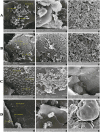A novel portable immuno-device for the recognition of lymphatic vessel endothelial hyaluronan receptor-1 biomarker using GQD-AgNPrs conductive ink stabilized on the surface of cellulose
- PMID: 37876653
- PMCID: PMC10591117
- DOI: 10.1039/d3ra06025j
A novel portable immuno-device for the recognition of lymphatic vessel endothelial hyaluronan receptor-1 biomarker using GQD-AgNPrs conductive ink stabilized on the surface of cellulose
Abstract
Lymphatic vessel endothelium expresses various lymphatic marker molecules. LYVE-1, the lymphatic vessel endothelial hyaluronan (HA) receptor, a 322-residue protein belonging to the integral membrane glycoproteins which is found on lymph vessel wall and is completely absent from blood vessels. LYVE-1 is very effective in the passage of lymphocytes and tumor cells into the lymphatics. As regards cancer metastasis, in vitro studies indicate LYVE-1 to be involved in tumor cell adhesion. Researches show that, in neoplastic tissue, LYVE-1 is limited to the lymphovascular and could well be proper for studies of tumor lymphangiogenesis. So, the monitoring of LYVE-1 level in human biofluids has provided a valuable approach for research into tumor lymphangiogenesis. For the first time, an innovative paper-based electrochemical immune-platform was developed for recognition of LYVE-1. For this purpose, graphene quantum dots decorated silver nanoparticles nano-ink was synthesized and designed directly by writing pen-on paper technology on the surface of photographic paper. This nano-ink has a great surface area for biomarker immobilization. The prepared paper-based biosensor was so small and cheap and also has high stability and sensitivity. For the first time, biotinylated antibody of biomarker (LYVE-1) was immobilized on the surface of working electrode and utilized for the monitoring of specific antigen by simple immune-assay strategy. The designed biosensor showed two separated linear ranges in the range of 20-320 pg ml-1 and 0.625-10 pg ml-1, with the acceptable limit of detection (LOD) of 0.312 pg ml-1. Additionally, engineered immunosensor revealed excellent selectivity that promises its use in complex biological samples and assistance for biomarker-related disease screening in clinical studies.
This journal is © The Royal Society of Chemistry.
Conflict of interest statement
The authors declare that they have no known competing financial interests or personal relationships that could have appeared to influence the work reported in this paper.
Figures






References
LinkOut - more resources
Full Text Sources
Research Materials
Miscellaneous

